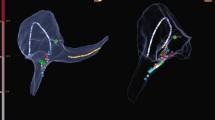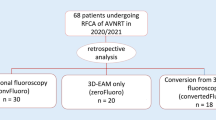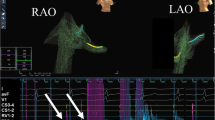Abstract
Purpose
Radiofrequency catheter ablation (RFCA) of supraventricular tachyarrhythmias carries a small but non-negligible radiation risk. Studies in children already showed the feasibility of using three-dimensional mapping systems as the primary guide for catheter visualization and positioning in these RFCAs. We aim to demonstrate the feasibility and safety of such an approach in young and middle-aged patients.
Methods
Fifty patients (age 34 ± 12) with supraventricular tachyarrhythmias underwent electrophysiological study; of these, 47 patients proceeded to RFCA guided by the EnSite NavXTM system (23 with atrioventricular nodal reentry tachycardia, 16 with an accessory pathway, six with typical atrial flutter, and two with right atrial tachycardia).
Results
In 38/50 cases (76%), electroanatomical mapping avoided fluoroscopy entirely, including four cases requiring access to the left heart chambers by a retrograde approach. In the remaining 12/50 cases (24%), fluoroscopy use was limited to 122 ± 80 s, with a correspondingly low radiation exposure (dose area product 1.3 ± 1.1 mGy × m2). All procedures were acutely successful, with a procedural time of 113 ± 37 minutes, and without incurring in any major complication. Over a mean follow-up of 12 ± 3 months, we observed one recurrence of pre-excitation and one relapse of atrial flutter.
Conclusions
Our study shows that non-fluoroscopic RFCA of supraventricular tachyarrhythmias using the EnSite NavXTM system is feasible, safe, and effective in a population of relatively young adults. Our experience of a non-fluoroscopic approach in these procedures deserves consideration, particularly in the young or in other patients at higher radiation risk.



Similar content being viewed by others
References
Cappato, R., & Kuck, K. H. (2000). Catheter ablation in the year 2000. Current Opinion in Cardiology, 15, 29–40.
Perisinakis, K., Damilakis, J., Theocharopoulos, N., Manios, E., Vardas, P., & Gourtsoyiannis, N. (2001). Accurate assessment of patient effective radiation dose and associated detriment risk from radiofrequency catheter ablation procedures. Circulation, 104, 58–62.
Smith, I. R., Rivers, J. T., Hayes, J., Stafford, W., & Codd, C. (2009). Reassessment of radiation risks from electrophysiology procedures compared to coronary angiography. Heart, Lung & Circulation, 18, 191–9.
Einstein, A. J. (2009). Medical imaging: the radiation issue. Nature Reviews Cardiology, 6, 436–8.
Hirshfeld, J. W., Jr., Balter, S., Brinker, J. A., Kern, M. J., Klein, L. W., Lindsay, B. D., et al. (2005). ACCF/AHA/HRS/SCAI clinical competence statement on physician knowledge to optimize patient safety and image quality in fluoroscopically guided invasive cardiovascular procedures: a report of the American College of Cardiology Foundation/American Heart Association/American College of Physicians Task Force on Clinical Competence and Training. Circulation, 111, 511–32.
Packer, D. L. (2005). Three-dimensional mapping in interventional electrophysiology: techniques and technology. Journal of Cardiovascular Electrophysiology, 16, 1110–6.
Estner, H. L., Deisenhofer, I., Luik, A., Ndrepepa, G., von Bary, C., Zrenner, B., et al. (2006). Electrical isolation of pulmonary veins in patients with atrial fibrillation: reduction of fluoroscopy exposure and procedure duration by the use of a non-fluoroscopic navigation system (NavX). Europace, 8, 583–7.
Rotter, M., Takahashi, Y., Sanders, P., Haissaguerre, M., Jais, P., Hsu, L. F., et al. (2005). Reduction of fluoroscopy exposure and procedure duration during ablation of atrial fibrillation using a novel anatomical navigation system. European Heart Journal, 26, 1415–21.
Sporton, S. C., Earley, M. J., Nathan, A. W., & Schilling, R. J. (2004). Electroanatomic versus fluoroscopic mapping for catheter ablation procedures: a prospective randomized study. Journal of Cardiovascular Electrophysiology, 15, 310–5.
Papagiannis, J., Tsoutsinos, A., Kirvassilis, G., Sofianidou, I., Koussi, T., Laskari, C., et al. (2006). Nonfluoroscopic catheter navigation for radiofrequency catheter ablation of supraventricular tachycardia in children. Pacing and Clinical Electrophysiology, 29, 971–8.
Drago, F., Silvetti, M. S., Di Pino, A., Grutter, G., Bevilacqua, M., & Leibovich, S. (2002). Exclusion of fluoroscopy during ablation treatment of right accessory pathway in children. Journal of Cardiovascular Electrophysiology, 13, 778–82.
Papez, A. L., Al-Ahdab, M., Dick, M., & Fischbach, P. S. (2007). Impact of a computer assisted navigation system on radiation exposure during pediatric ablation procedures. Journal of Interventional Cardiac Electrophysiology, 19, 121–7.
Smith, G., & Clark, J. M. (2007). Elimination of fluoroscopy use in a pediatric electrophysiology laboratory utilizing three-dimensional mapping. Pacing and Clinical Electrophysiology, 30, 510–8.
Tuzcu, V. (2007). A nonfluoroscopic approach for electrophysiology and catheter ablation procedures using a three-dimensional navigation system. Pacing and Clinical Electrophysiology, 30, 519–25.
Kammeraad, J., Udink ten Cate, F., Simmers, T., Emmel, M., Wittkampf, F. H., & Sreeram, N. (2004). Radiofrequency catheter ablation of atrioventricular nodal reentrant tachycardia in children aided by the LocaLisa mapping system. Europace, 6, 209–14.
Earley, M. J., Showkathali, R., Alzetani, M., Kistler, P. M., Gupta, D., Abrams, D. J., et al. (2006). Radiofrequency ablation of arrhythmias guided by non-fluoroscopic catheter location: a prospective randomized trial. European Heart Journal, 27, 1223–9.
Alvarez, M., Tercedor, L., Almansa, I., Ros, N., Galdeano, R. S., Burillo, F., et al. (2009). Safety and feasibility of catheter ablation for atrioventricular nodal re-entrant tachycardia without fluoroscopic guidance. Heart Rhythm, 6, 1714–20.
Hindricks, G., Willems, S., Kautzner, J., De Chillou, C., Wiedemann, M., Schepel, S., et al. (2009). Effect of electroanatomically guided versus conventional catheter ablation of typical atrial flutter on the fluoroscopy time and resource use: a prospective randomized multicenter study. Journal of Cardiovascular Electrophysiology, 20(7), 734–40.
Blomström-Lundqvist, C., Scheinman, M. M., Aliot, E. M., Alpert, J. S., Calkins, H., Camm, A. J., et al. (2003). ACC/AHA/ESC guidelines for the management of patients with supraventricular arrhythmias-executive summary. Circulation, 108, 1871–909.
Committee to Assess Health Risks from Exposure to Low Levels of Ionizing Radiation BoRER, Division on Earth and Life Studies, National Research Council of the National Academies (2006) Health risks from exposure to low levels of ionizing radiation: BEIR VII-phase 2. Washington, DC; National Academies Press.
Ait-Ali, L., Andreassi, M. G., Foffa, I., Spadoni, I., Vano, E., & Picano, E. (2010). Cumulative patient effective dose and acute radiation-induced chromosomal DNA damage in children with congenital heart disease. Heart, 96(4), 269–74.
Andreassi, M. G., Ait-Ali, L., Botto, N., Manfredi, S., Mottola, G., & Picano, E. (2006). Cardiac catheterization and long-term chromosomal damage in children with congenital heart disease. European Heart Journal, 27, 2703–8.
Bedetti, G., Botto, N., Andreassi, M. G., Traino, C., Vano, E., & Picano, E. (2008). Cumulative patient effective dose in cardiology. The British Journal of Radiology, 81, 699–705.
Beels, L., Bacher, K., De Wolf, D., Werbrouck, J., & Thierens, H. (2009). gamma-H2AX foci as a biomarker for patient X-ray exposure in pediatric cardiac catheterization: are we underestimating radiation risks? Circulation, 120, 1903–9.
Brenner, D. J., & Hall, E. J. (2007). Computed tomography—an increasing source of radiation exposure. The New England Journal of Medicine, 357, 2277–84.
Fazel, R., Krumholz, H. M., Wang, Y., Ross, J. S., Chen, J., Ting, H. H., et al. (2009). Exposure to low-dose ionizing radiation from medical imaging procedures. The New England Journal of Medicine, 361, 849–57.
Pachon, M., Arias, M. A., Castellanos, E., & Puchol, A. (2009). No fluoroscopy for cavotricuspid isthmus-dependent right atrial flutter ablation. Heart Rhythm, 6, 433–4.
Venneri, L., Rossi, F., Botto, N., Andreassi, M. G., Salcone, N., Emad, A., et al. (2009). Cancer risk from professional exposure in staff working in cardiac catheterization laboratory: insights from the National Research Council's Biological Effects of Ionizing Radiation VII Report. American Heart Journal, 157, 118–24.
Author information
Authors and Affiliations
Corresponding author
Rights and permissions
About this article
Cite this article
Casella, M., Pelargonio, G., Dello Russo, A. et al. “Near-zero” fluoroscopic exposure in supraventricular arrhythmia ablation using the EnSite NavX™ mapping system: personal experience and review of the literature. J Interv Card Electrophysiol 31, 109–118 (2011). https://doi.org/10.1007/s10840-011-9553-5
Received:
Accepted:
Published:
Issue Date:
DOI: https://doi.org/10.1007/s10840-011-9553-5




